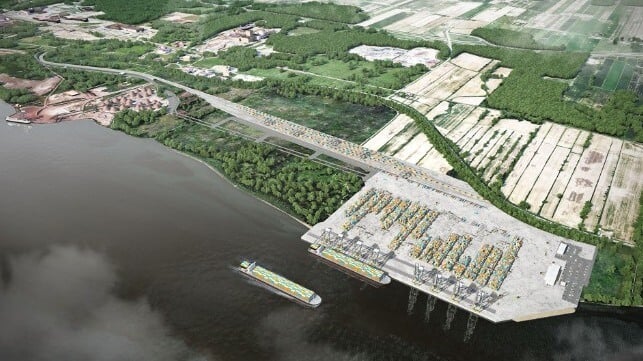Port of Montreal's New Container Terminal May Need a New Rail Line

Prior to the recent port workers’ strike, the Port of Montreal maritime container transshipment terminal located on the southeastern side of the island of Montreal was approaching operational capacity. Plans to build an additional terminal east of Montreal raise concerns about the railway connection to points west of that terminal.
Introduction
Canada’s inland Port of Montreal is located along the Lower Saint Lawrence River, which - despite frigid winter temperatures - remains open to navigation year round. The St. Lawrence Seaway, located west of Montreal, closes to shipping during the northern winter months. The port has transformed over a period of decades from handling crates and palates to transferring shipping containers between maritime and surface transportation, involving both trucks and railway transportation. Institutional obstacles discourage container shipping to/from Canadian inland ports located west of Montreal, leaving Port of Montreal to handle containers destined for the more heavily populated province of Ontario.
Development is under way near the town of Contrecoeur, Quebec to build a container transshipment terminal that would increase Port of Montreal's total annual container handling capacity by 40%, or up to 3.3 million TEU annually. Contrecoeur terminal will be located next to a major highway that allows passage to extended-length trucks. A branch railway line that passes through residential areas and along city streets provides passage to one or two short trains that operate daily at low speed, connecting Contrecoeur to Montreal.
The Railway Line
This author was invited to look at the railway line, which is located parallel to urban roads in residential areas. It is an old line that serves local industries and carries one or two short freight trains per day that travel at low speed, with minimal delay at a multitude of grade crossings. The railway line crosses over two multi-lane divided highways at grade-level crossings that require road traffic to stop, with short trains causing minimal delay to road traffic.
Following completion, Contrecoeur terminal would be able to berth ships of up to 140-feet width by over 1,000-feet length that carry 3,500 to 7,000 TEU, which will be transferred to trains of up to 8,000-feet in length each. Trains that presently travel along the line rarely exceed 800 feet in length.
Future arrival of container ships at Contrecoeur will result in several trains per day within a few hours of each other when ships are in port, traveling next to residential streets. Vibration caused by frequent long container trains passing by has the potential to reduce property values and cause damage to homes. Citizens would likely appreciate any willingness by authorities behind the development of Contrecoeur container terminal to consider an alternate future railway line that bypasses residential areas, with potential to carry extended-length container trains of over 11,000-feet in length.
Alternate Railway Line
Investment at Contrecoeur is creating direct employment for local residents, with indirect employment involving businesses such as supermarkets, restaurants and numerous retail and service sector businesses. The construction of a new stretch of railway line going south toward a main east-west railway line located to the south of the Trans-Canada Highway, would require investment that would in turn create employment in the construction sector and related industries. There may be need for a railway bridge across the Richelieu River and a railway tunnel under the Trans-Canada Highway, with area citizens welcoming new employment opportunities.
An alternate railway line extending south from Contrecoeur terminal would be well suited to frequent departures of container trains that could travel at higher speed.
Conclusions
Projected future increases in container traffic and transshipment volumes at the Port of Montreal require new development to increase container transshipment capacity, hence the development of the Contrecoeur terminal. The railway branch line that connects between Contrecoeur terminal and Montreal might be able to occasionally carry a container train of 8,000-feet in length during the overnight hours. Regular operation involving several such trains per day would require an alternate railway line capable of carrying container trains of over 11,000-feet in length, which would reduce both carbon emissions as well as transportation cost per container.
The opinions expressed herein are the author's and not necessarily those of The Maritime Executive.
